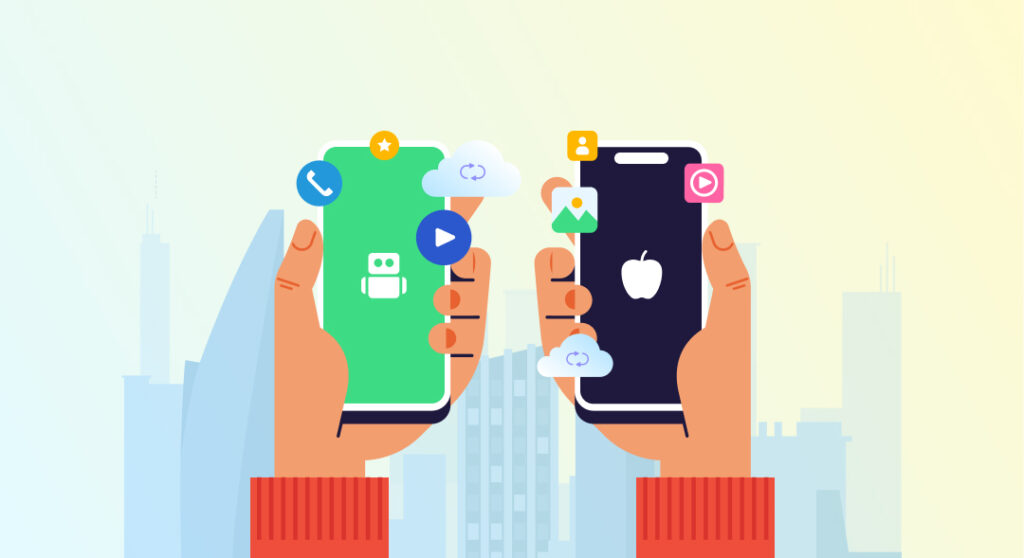
Success Beyond Platforms: We Weigh In On Apple vs Android

Say all you want about Apple, but its influence on technology and culture is undeniable. This fruit has set trends with innovations like the iPod and iPhone, and people all over the world are in love with their sleek designs.
Is it outrageously expensive? Yes.
Is it a closed system that will suck you in and force you to buy more Apple products to continue seamlessly using technology for your benefit? Also yes.
Are we still tempted to buy it? …yes.
Table of Contents
The early days of switching
Initially, moving from Android to iPhone felt like packing up your entire digital life and hoping everything would fit into your new home. Contacts, photos, media, and app data were all locked away in Android’s ecosystem, and moving them required a mix of manual transfers, third-party apps, and plenty of digital gymnastics.
These were dark times, where users needed to choose between losing valuable app data or spending ages backing up, converting, and transferring information correctly. And once everything they finally needed crossed over, their next challenge was to figure out how to navigate an all-new user interface and operating system.
What does this square button that floats everywhere do?
Where’s my internet browser?
Why can’t I find my favorite games on the Apple Store?
And the list goes on…
It’s all coming together – in a good way!
But as technology advanced, the boundaries between Android and iPhone ecosystems began to blur. Thankfully, both Google and Apple recognized the need for smoother transitions between platforms. They developed tools and services to facilitate these changes.
Apple’s “Move to iOS” app, introduced in 2015, marked a significant step towards easing this process. It allowed Android users to wirelessly transfer contacts, message history, camera photos and videos, web bookmarks, mail accounts, and calendars directly to a new iPhone.
On the software and app front, the evolution of cloud services has been a game-changer. With most users storing their data in cloud services like Google Drive, Dropbox, or iCloud, accessing your information from any device has become more straightforward.
This cloud-centric approach to data storage and app design means that switching devices no longer requires a cumbersome transfer of files and information. Apps now offer cross-platform compatibility, making it easier to pick up on an iPhone where you left off on an Android device.
How it’s going at the moment
Today, the transition from Android to iPhone is more about acclimatizing to a new operating system than about moving data. The ecosystems have evolved to be more inclusive, allowing for a range of services and apps to be used across both platforms.
Messaging apps like WhatsApp and social media platforms like Facebook and Instagram offer seamless experiences on both Android and iPhone, reducing the friction of switching.
Moreover, the focus on user experience and interface design has led to a more intuitive understanding of operating systems. While there are still differences between Android and iOS, the gap in usability has significantly narrowed.
Features like predictive text, gesture controls, and voice assistants have become standard across devices, making the switch feel less like learning a new language and more like adjusting to a new dialect,
Embracing lifelong learning
It’s worth noting that this ease in transition is made possible because several applications and service providers surrounding these two giants worked hard to create a seamless transition from one operating system to the other.
Alvin Toffler, an American writer, once wrote: “The illiterate of the 21st century will not be those who cannot read and write, but those who cannot learn, unlearn and relearn.”
And just as technology giants have simplified the OS transition through better integration and compatibility, we provide crucial solutions that ensure seamless data management and an enhanced user experience regardless of the underlying technology.
Enhancing data quality across systems
All our products and services facilitate data quality and consistency, which are vital in maintaining seamless operations across diverse systems. Whether a business is running on a legacy system or the latest software, our products can be tailored to ensure effective communication between systems, minimizing errors and improving efficiency.
This capability is especially important in today’s digital environment where accurate data is crucial for successful business operations and customer satisfaction.
And by integrating DataTools’ solutions, companies can provide a cohesive and user-friendly experience to their customers – a lot like the smooth transitions users now expect when switching between different operating systems.
We can seamlessly integrate with multiple systems for maintaining data accuracy and help with any data migration efforts.
If that sounds like something you need help with, book a call with one of our data quality specialists here.




